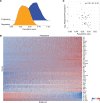Single-cell analysis of fate-mapped macrophages reveals heterogeneity, including stem-like properties, during atherosclerosis progression and regression
- PMID: 30830865
- PMCID: PMC6478411
- DOI: 10.1172/jci.insight.124574
Single-cell analysis of fate-mapped macrophages reveals heterogeneity, including stem-like properties, during atherosclerosis progression and regression
Abstract
Atherosclerosis is a leading cause of death worldwide in industrialized countries. Disease progression and regression are associated with different activation states of macrophages derived from inflammatory monocytes entering the plaques. The features of monocyte-to-macrophage transition and the full spectrum of macrophage activation states during either plaque progression or regression, however, are incompletely established. Here, we use a combination of single-cell RNA sequencing and genetic fate mapping to profile, for the first time to our knowledge, plaque cells derived from CX3CR1+ precursors in mice during both progression and regression of atherosclerosis. The analyses revealed a spectrum of macrophage activation states with greater complexity than the traditional M1 and M2 polarization states, with progression associated with differentiation of CXC3R1+ monocytes into more distinct states than during regression. We also identified an unexpected cluster of proliferating monocytes with a stem cell-like signature, suggesting that monocytes may persist in a proliferating self-renewal state in inflamed tissue, rather than differentiating immediately into macrophages after entering the tissue.
Keywords: Atherosclerosis; Cardiology; Immunology; Macrophages; Molecular diagnosis.
Conflict of interest statement
Figures







Similar articles
-
Inflammatory Ly6Chi monocytes and their conversion to M2 macrophages drive atherosclerosis regression.J Clin Invest. 2017 Aug 1;127(8):2904-2915. doi: 10.1172/JCI75005. Epub 2017 Jun 26. J Clin Invest. 2017. PMID: 28650342 Free PMC article.
-
Human CD16+ monocytes promote a pro-atherosclerotic endothelial cell phenotype via CX3CR1-CX3CL1 interaction.Cardiovasc Res. 2021 May 25;117(6):1510-1522. doi: 10.1093/cvr/cvaa234. Cardiovasc Res. 2021. PMID: 32717023
-
Adoptive transfer of CX3CR1 transduced-T regulatory cells improves homing to the atherosclerotic plaques and dampens atherosclerosis progression.Cardiovasc Res. 2021 Jul 27;117(9):2069-2082. doi: 10.1093/cvr/cvaa264. Cardiovasc Res. 2021. PMID: 32931583
-
[Macrophage activation in atherosclerosis. Message 1: Activation of macrophages normally and in atherosclerotic lesions].Patol Fiziol Eksp Ter. 2015 Jul-Sep;(3):128-31. Patol Fiziol Eksp Ter. 2015. PMID: 26852607 Review. Russian.
-
Changes in transcriptome of macrophages in atherosclerosis.J Cell Mol Med. 2015 Jun;19(6):1163-73. doi: 10.1111/jcmm.12591. Epub 2015 May 13. J Cell Mol Med. 2015. PMID: 25973901 Free PMC article. Review.
Cited by
-
Characterization of prostate macrophage heterogeneity, foam cell markers, and CXCL17 upregulation in a mouse model of steroid hormone imbalance.Sci Rep. 2024 Sep 9;14(1):21029. doi: 10.1038/s41598-024-71137-4. Sci Rep. 2024. PMID: 39251671 Free PMC article.
-
Autoimmune diseases and atherosclerotic cardiovascular disease.Nat Rev Cardiol. 2024 Nov;21(11):780-807. doi: 10.1038/s41569-024-01045-7. Epub 2024 Jun 27. Nat Rev Cardiol. 2024. PMID: 38937626 Review.
-
Heterogeneous subpopulations of adventitial progenitor cells regulate vascular homeostasis and pathological vascular remodelling.Cardiovasc Res. 2022 May 6;118(6):1452-1465. doi: 10.1093/cvr/cvab174. Cardiovasc Res. 2022. PMID: 33989378 Free PMC article. Review.
-
Overview of the cardiovascular effects of environmental metals: New preclinical and clinical insights.Toxicol Appl Pharmacol. 2022 Nov 1;454:116247. doi: 10.1016/j.taap.2022.116247. Epub 2022 Sep 17. Toxicol Appl Pharmacol. 2022. PMID: 36122736 Free PMC article.
-
Meta-Analysis of Leukocyte Diversity in Atherosclerotic Mouse Aortas.Circ Res. 2020 Jul 17;127(3):402-426. doi: 10.1161/CIRCRESAHA.120.316903. Epub 2020 Jul 16. Circ Res. 2020. PMID: 32673538 Free PMC article. Review.
References
Publication types
MeSH terms
Substances
Grants and funding
LinkOut - more resources
Full Text Sources
Other Literature Sources
Medical
Molecular Biology Databases

